Summary
Barrio Viejo, also known as “Barrio Libre”, is a neighborhood that is located the downtown section of Tucson, Arizona. The name translates to English as "Old Neighborhood". The neighborhood was a cultural center of Tucson as it was the home to many immigrants, including Mexican, Chinese, African and other European countries as well. Many parts of the Barrio were destroyed in the mid to late 1900’s, but some has survived and makes up the neighborhood as it stands now. Today, Barrio Viejo has one of the largest collection of 19th century adobe buildings in the US, with the current borders of Cushing Street to the north, Sixth Avenue to the east, I-10 to the west, and 18th Street to the south. The barrio originally stretched all the way up to Broadway Boulevard, bordered by Main Avenue on the west but has been reduced over time.
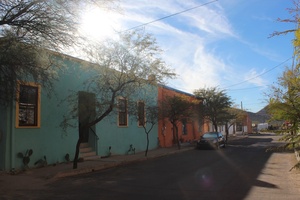 Colorful adobe homes in Barrio Viejo. Photo by Julia Van Valkenburg.
Colorful adobe homes in Barrio Viejo. Photo by Julia Van Valkenburg.
Beginning of Barrio Viejo
Barrio Viejo was one of the original urban communities in Tucson and when it was first developed in the mid 19th century. For many years, the neighborhood fell outside of the jurisdiction of the City of Tucson where it got its original name, Barrio Libre “Free Neighborhood”. During this time, the neighborhood became very similar to its own city, which included restaurants and stores along with the adobe homes, many of which served as both homes and a storefront as well. The neighborhood was was mostly consistent of working-class Mexican families during its early years in existence. It slowly became more diverse when the Southern Pacific Railroad came into Tucson in the 1880’s, bringing a wave of Chinese immigrants to the area who began to also build homes, shops and restaurants of their own. In 1881, the Tucson City Directory wrote that, "Main, Pennington, Congress and Meyer Streets, and Stone, Toole and Osborne Avenues are among the most spacious and promising thoroughfares...". For many decades, Barrio Viejo would become the cultural heart of Tucson as it was a living, breathing example of Tucson's diverse cultures coming together in an urban community with its colorful adobe homes and businesses that filled the neighborhood.
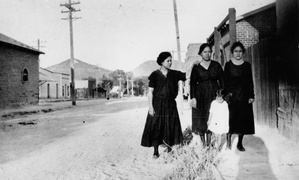 Women on a street in Tucson's Barrio Viejo with A Mountain in background, circa 1920. Photo from the Arizona Historical Society.
Women on a street in Tucson's Barrio Viejo with A Mountain in background, circa 1920. Photo from the Arizona Historical Society.
Urban Redevelopment and Gentrification
In the 1960's and 70's, developers started destroying homes in the northern part of the neighborhood in order to build the Tucson Convention Center. The construction of the convention center began in 1971 and led to the razing of even more homes and businesses in the neighborhood, displacing 725 residents. This forced act of gentrification has come to define the neighborhood's spirit and its role as a historical area of Tucson. Throughout the 1970's, white-middle class families began moving into homes north of 22nd Street, near Barrio Viejo. Attracted to the old and authentic styles of the buildings, the income shift in the Barrio population brought on gentrification that forced many of the original Mexican American residents out of their homes. In response to the growing tension between the new and former residents of the neighborhood, the City of Tucson developed the "Comprehensive Community Development Plan for the Greater Santa Rosa Area" to try and resolve these disagreements.
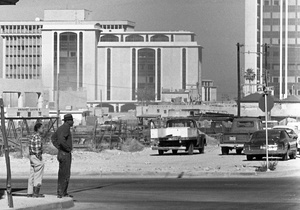 A couple gentlemen stand on West 14th Street (later became Cushing Street) and possibly South Church Avenue as construction continues on the Tucson Convention Center on December 4, 1970. The site of many adobe homes and businesses in Barrio Viejo. Photo by Art Grasberger.
A couple gentlemen stand on West 14th Street (later became Cushing Street) and possibly South Church Avenue as construction continues on the Tucson Convention Center on December 4, 1970. The site of many adobe homes and businesses in Barrio Viejo. Photo by Art Grasberger.
Further Attempts at Redevelopment
After the major controversy of the TCC, residents of Barrio Viejo and adjacent Barrio Santa Rosa prevented another project, a freeway called the Butterfield Expressway, from being built. The proposed freeway would have demolished many of the homes in the neighborhood in order to shorten travel from Eastern Tucson to the downtown area. After seeing the destruction of the neighborhood that happened with the construction of the convention center, the community took action and protested against further demolition of the neighborhood. After years of fighting and controversies regarding the deconstruction of Barrio Viejo, the state decided to stop further deconstruction in 1972. Although further destruction stopped, hundreds of homes, many of which were over a hundred years old, were destroyed and hundreds of people were displaced due to the “redevelopment” of the area.
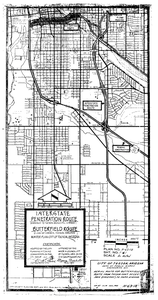 Blueprints of the Butterfield Expressway. Photo from the City of Tucson Record Archives.
Blueprints of the Butterfield Expressway. Photo from the City of Tucson Record Archives.
Revitalization of Barrio Viejo
Among the surviving building in Barrio Viejo, many of them fell into disrepair and were in need of a significant rehaul to prevent them from being completely destroyed. In response to the disrepair, In 1971, Tucsonan Harry Kelley Rollings became inspired by the will of the residents in the neighborhood to preserve its history, which led to a movement that envisioned a revitalized Barrio Viejo. Community members, homeowners and business owners came together to reestablish the vibrancy that this historic neighborhood once held in years past. Thanks to the help of Rollings and many members of the Tucson community, what was left of Barrio Viejo was rehauled with many buildings being restored and revitalized during the 1970’s. In 1977, Barrio Viejo and a few other historic neighborhoods in the area were added to the National Register of Historic Places and was rezoned by the City of Tucson as a Historic Preservation Zone in 1978, stopping future destruction of the neighborhood and surrounding areas.
Barrio Viejo Today
Today, Barrio Viejo is a beautiful and vibrant neighborhood, giving visitors a glimpse as to what the neighborhood looked like during its height in the late 19th and early 20th century. Many law offices and other local businesses now fill the historic homes in the neighborhood, but Barrio Viejo still has a strong community base that continues to keep its spirit alive and well, and safe from further demolition. Many of these historic homes, however, still serve as homes for the residents of the area and the community continues to grow stronger.
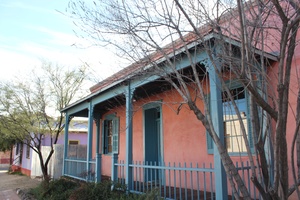 Revitalized adobe homes in Barrio Viejo. Photo by Julia Van Valkenburg.
Revitalized adobe homes in Barrio Viejo. Photo by Julia Van Valkenburg.
Notable Places in Barrio Viejo
Teatro Carmen – The theatre was opened in May of 1915 by founder Carmen Soto Vásquez. The theatre is particularly famous because it was one of the first theatres in Tucson that was exclusive to theatrical works that were in Spanish. During its five years as a theatre for plays, the venue hosted hundreds of plays from many companies who were local as well as international talent from Mexico and Spain. In 1920, as movies and other live events such as boxing were becoming more popular, the theatre closed its doors and reopened later that year and reopened as a new venue that could have boxing matches, a ballroom, a movie theatre and a few theatrical performances. After the conversion, many Mexican companies began not wanting to travel across the border to Tucson, and this forced Vásquez to sell the theatre in 1926, where it became an auto garage and later a church lodge in the late 1930’s. During the gentrification of the area that took place between 1950 and 1980, the theatre was at risk of being demolished but was ultimately spared from being destroyed. In 1985, the theatre was added to the Tucson-Pima County Historical Commission and the Arizona Historical Society for its role as a historic cultural center. Today, the theatre still stands in the Barrio and is owned privately so the public are unable to enter, put tourists are able to see the outside and the plaque set by the historical society.
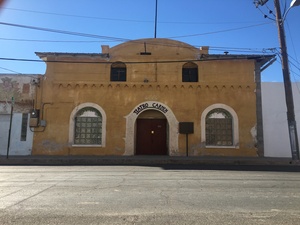 Teatro Carmen, once the premiere theater for the presentation of Spanish Language dramas. Photo by Sean Orth.
Teatro Carmen, once the premiere theater for the presentation of Spanish Language dramas. Photo by Sean Orth.
El Tiradito Wishing Shrine – Roughly translates to “The Little Throwaway” or “The Castaway” is a shrine located within Barrio Viejo. The shrine is the only one of its kind in the United States, because it is dedicated to a sinner who was not buried on holy ground named Juan Oliveras. The legend says that in the 1870’s, Juan was having an affair with his mother in law, who was also the wife of a very wealthy and powerful rancher in Tucson. One day Juan and his mother and law were caught by the father in law having sex and Juan was murdered by him with an axe in the middle of the street. Residents from the Barrio begged the Catholic Church in Tucson to have Juan buried in their cemetery, but due to the adulterous nature of his death, the church denied their requests. After constant denials from the church, Juan was supposedly buried in the same place where he was murdered, which was the original spot of the shrine. In the 1920’s, the shrine was moved and today, the shrine is still standing and is visited by hundreds of thousands of people each year, some of which light candles to pray for the soul of Juan as well as to remember those who have passed and to ask for personal prayers of forgiveness. El Tiradito was added to the National Register of Historic Places in 1971 as well as the Tucson-Pima County Historical Commission and the Arizona Historical Society in 1988.
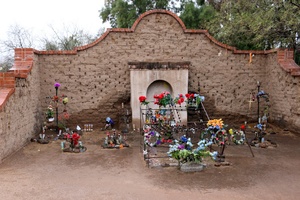 El Tiradito Wishing Shrine with candles and flowers left by visitors. Photo by Todd DeFeo.
El Tiradito Wishing Shrine with candles and flowers left by visitors. Photo by Todd DeFeo.
El Parque de San Cosmé – The park is located in the heart of the Barrio Viejo and serves many purposes other than that of just a park where people can gather. The park is set in a typical desert landscape with many benches and pathways, including a small orange tree orchard. Within the 0.8 acre park, there is a section of a preserved El Paso – Southwestern Railroad track that stands as a museum to the railroad community that built the Barrio Viejo in the late 1800’s. The park is also home to a small chapel that is dedicated to San Cosmé as well as a memorial to the Barrio Viejo.
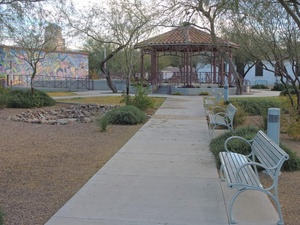 El Parque de San Cosmé, with the mural of Barrio Viejo history that can be seen on the left. Photo by Jerry Peek.
El Parque de San Cosmé, with the mural of Barrio Viejo history that can be seen on the left. Photo by Jerry Peek.
Velasco House – The house was built around 1850 but gained further significance in 1865 when it was purchased by Carlos Ygnacio Velasco in 1865. Velasco bought the house and opened up a market close by in the Barrio Viejo. In 1878, Velasco decided that it was time to sell his store and instead decided to start a publishing company within his home. Velasco began to publish his newspaper “El Fronterizo”, which became very popular in the Mexican state of Sonora as well as in Arizona and was the first newspaper that was published in Spanish in Tucson. The printing press that Velasco used for his newspaper was also the same printing press that was used to publish the first ever newspaper in Arizona in 1859. The newspaper stayed very successful in the Southern Arizona and Sonora area for decades until Velasco’s death in 1914, when the newspaper was eventually dissolved. The house is now privately owned and has been a part of the National Register of Historic Places since 1974.
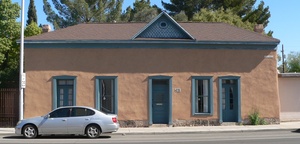 Velasco House as seen from the front. Photo by Anonymous.
Velasco House as seen from the front. Photo by Anonymous.
Carillo House – Also known as the Fremont House, Leopold Carillo House among others. The house was built around 1858 and is one of the few surviving homes that uses the Zaguan house plan, which was very common in Tucson in the late 19th century. The home is commonly referred to as the Sosa-Carillo-Fremont home, the names referring to some of the major families and historical figures that are tied to the home. The home was first owned by Jose Maria Sosa and was later sold to Jesus Suarez Carillo, the wife of famed Tucson businessman, Leopold Carillo. The house gets much of its fame as it is said that famed military commander and later Governor of the Arizona Territory, John Fremont and his family lived in the Carillo house when Tucson was the capital of the territory in the late 1860’s and 1870’s. However, historians are still unsure if this story is true, but the story is widely renowned as being true in the local area. Today, the house is a museum that aims to show the heritage of Mexican-Americans in Southern Arizona during the mid to late 1800’s. The home has also been a part of the National Register of Historic Places since 1971.
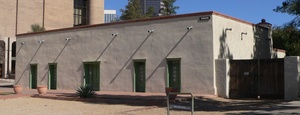 Carillo House as seen from the front. Photo by Anonymous.
Carillo House as seen from the front. Photo by Anonymous.
Cushing Street Bar – The building was constructed in the 1860’s by Joseph Ferrin who immigrated to Tucson from Germany with his family and ran a general store in the building, which was also the family home. His wife, Therese helped to create the Stone Street Temple, which was the first of its kind in Tucson. The home was later owned by their daughter, Clara Ferrin Bloom, who was one of the most notable women’s community leaders in the Tucson during the early to mid 1900’s. During the revitalization of Barrio Viejo, the building was falling into disrepair and was later reconstructed and reopened as the Cushing Street Bar by the Rollings family in 1972. The bar was sold in 2018 and reopened as The Coronet restaurant in summer of 2019, where it still resides today.
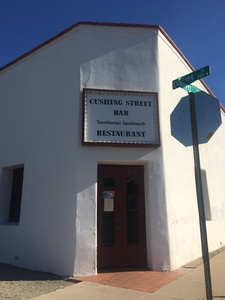 Old Cushing Street Bar and Restaurant. Photo by Sean Orth.
Old Cushing Street Bar and Restaurant. Photo by Sean Orth.
References:
Barrio Viejo neighborhood website history
Graves, Tammi. "Photos: Let's go for a walk in Barrio Viejo." Arizona Daily Star, 2014
Innes, Stephanie. "New brochure tells history of pre-TCC neighborhood." Arizona Daily Star. 2010.
Downtown Tucson Partnership website: Neighborhoods
https://azmemory.azlibrary.gov/digital/collection/ahsmexican/id/274/
https://loc.gov/pictures/item/az0645/
http://www.tucsonmuseum.org/shrinecurse.htm
https://www.hmdb.org/m.asp?m=83030
https://www.visittucson.org/business/parque-de-san-cosme
https://historicalmarkerproject.com/markers/HMHIR_carlos-ygnacio-velasco-house_Tucson-AZ.html
https://maps2.tucsonaz.gov/preservation/inventoryforms/IL_VelascoHouse.pdf
https://catalog.archives.gov/id/75610418
https://arizonahistoricalsociety.org/visit/historic-sites/
https://www.tucsonaz.gov/apps/maps-and-records/construction-plans/details/1995


